health and safety protocol and measurement
Download as PPTX, PDF0 likes45 views
Active recreation
1 of 19
Download to read offline
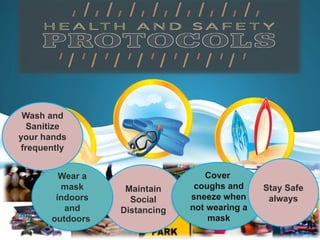
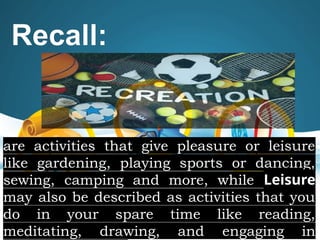

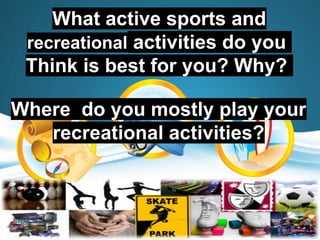
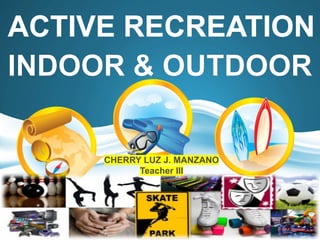
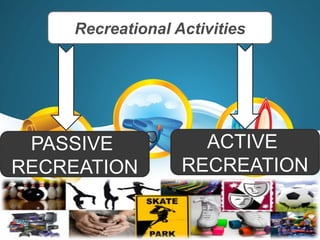
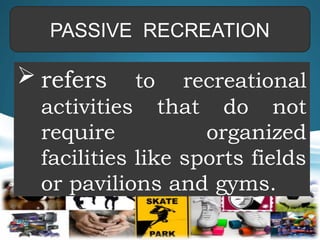
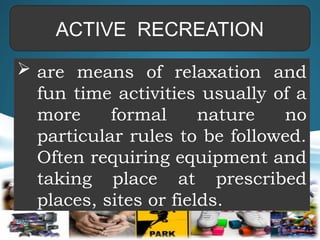
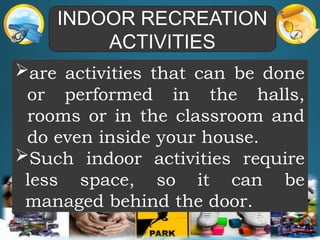

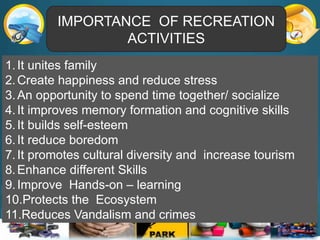
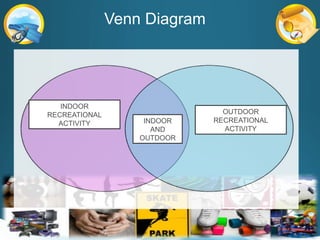
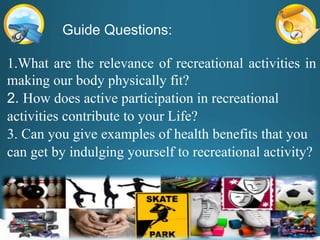
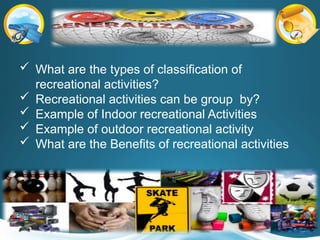
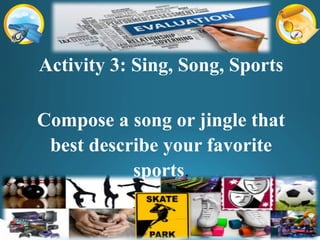
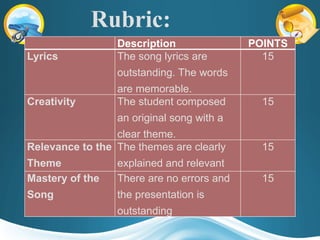


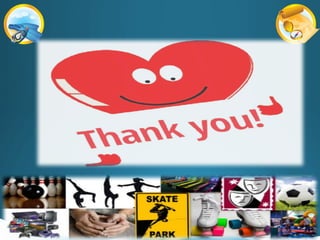
Ad
Recommended
COT-PPT-PE12 (1) (1) (1).pptx
COT-PPT-PE12 (1) (1) (1).pptxErmaAlivio1
╠²
This document provides information about classroom rules and recreational activities for a Physical Education and Health 12 class. It includes the following:
- Classroom rules about being on time, listening to the teacher, raising your hand before speaking or leaving your seat, and putting trash in the trashcan.
- Vocabulary words related to recreational activities.
- Objectives and activities to discuss classifications of recreational activities including arranging letters/puzzles and playing chess in groups.
- Descriptions of classifications like spectator, participant, active, and passive types of recreational activities.
- Questions for students and an assignment to identify recreational activities and benefits.Leisure time1
Leisure time1KhatunaJavari
╠²
Leisure time is defined as free time spent away from work, chores, and necessary activities like eating and sleeping. It is important for balance and enhancing skills like communication. Group leisure activities can help people socialize and benefit those who are shy. Leisure provides mental wellness benefits like stress reduction and prevents depression. It allows people to feel in control and enhances quality of life by improving self-esteem. There are different types of leisure like serious leisure as a hobby career, casual short-term leisure for enjoyment, and project or family-based leisure. Popular leisure activities vary between countries and cultures.PE9-Q4-MOD1.pdf
PE9-Q4-MOD1.pdfEllaFlorPalconaga
╠²
This document provides information about active and passive recreation. It defines passive recreation as activities that do not require organized facilities, while active recreation refers to more formal activities that usually take place in prescribed places or fields and often require equipment. It notes that both types of recreation are important for improving overall well-being and quality of life. The document also highlights that recreational activities promote inclusion and can be modified to accommodate people with disabilities.WLP-in-Psychosocial-Activities.docx
WLP-in-Psychosocial-Activities.docxLeahPaulynBascosBerg
╠²
This document contains a weekly learning plan for Grade 1 students at Don Andres G. Maiquez Memorial School in Urdaneta City, Pangasinan, Philippines for the first week of the first quarter from August 22-26, 2022. It includes 7 daily activities focused on developing students' concentration, relaxation, imagination, and self-awareness skills through games, guided imagery exercises, drawing, and dance. The activities are designed to be conducted both face-to-face and through modular learning formats.Leisure activities for teenagers
Leisure activities for teenagersAnethRamos1
╠²
This document discusses leisure activities among teenagers. It defines leisure as activities done for pleasure after responsibilities. The professor aims to discuss leisure choices, activities, and benefits among teenagers. The document categorizes leisure as social, creative, physical, cognitive, relaxation, and spiritual activities. It further divides activities into active ways like sports and passive ways like reading. Active leisure provides health benefits while passive provides relaxation. Overall, leisure improves health, relationships, and reduces stress for teenagers.Intro op 1.1 week 3
Intro op 1.1 week 3HCEfareham
╠²
This document discusses the importance of engagement in leisure and social activities for health and well-being. It provides tasks and questions to help understand how to take a person-centered approach to supporting individuals' interests and independence through activities. This includes exploring benefits of leisure activities for well-being, ways to find out about individuals' interests, and how to promote independence by supporting participation in meaningful activities.The five senses
The five sensesafrimogo
╠²
The document discusses the five senses - taste, touch, smell, hearing, and sight. It provides information about each sense, including the organ involved and examples of how each sense works. For taste, it describes how the tongue contains taste buds that identify flavors. For touch, it explains how nerves in the skin receive information about what is touched. For smell, it notes that air enters the nose and the olfactory nerve receives information and sends it to the brain. The document also includes suggested activities to teach about each sense.Recreation activities done for grade 8.pptx
Recreation activities done for grade 8.pptxwhiteblack25
╠²
Recreation activities done for grade 8.pptxLesson-8-Meaningful-life.pptx
Lesson-8-Meaningful-life.pptxJulietCanoog1
╠²
This document outlines the key points of a lesson about finding meaning and purpose in life in light of our impending death. It begins with rules for an in-person classroom setting and then lists objectives about defining a meaningful life and creating a bucket list. Various topics are discussed such as happiness, suffering, and what constitutes a meaningful life. Examples of meaningful activities are provided. Students are assigned to create their own bucket lists and do a role play demonstrating finding meaning through studying a favorite subject in school. Key expressions related to meaning and impermanence are also discussed.WLP-1st-week-psychosocial.docx
WLP-1st-week-psychosocial.docxLIEZELSERONDO2
╠²
- The document is a weekly learning plan for Grade 7 and 10 students at Libudon National High School covering the topic of Mental Health and Psychosocial Support over 5 days.
- On Day 1, students will identify personal, social, and emotional sources of strength and distinguish internal and external sources through drawing an analogy to parts of a tree. Day 2 focuses on goal setting and identifying goals and steps to achieve them.
- On Day 3, students describe physical stress reactions, acknowledge that stress reactions are normal, and learn relaxation techniques. Day 4 teaches how thoughts affect feelings and behaviors and introduces reframing negative thoughts. Day 5 reviews reframing thoughts, feelings, and behaviors through a flower-drawing activity.Power Point Presentation: Informative Speech Fall 2016
Power Point Presentation: Informative Speech Fall 2016libhgtc
╠²
This document provides guidance on delivering an informative speech. It explains that an informative speech increases the audience's knowledge on a topic by providing new information or a new perspective. It also discusses sample speech topics like hobbies. The document outlines the major parts of a speech, including the introduction with an attention-getter and thesis, body with examples and transitions, and conclusion which restates the thesis and leaves the audience thinking. It emphasizes practicing delivery through techniques like posture, eye contact, and voice modulation.HOW TO USE.pptx
HOW TO USE.pptxRussielDagohoy3
╠²
This packet is designed to promote psychosocial wellbeing and academic performance among students. It is divided into three parts - I AM, I CAN, I HAVE - to develop skills like safety, self-awareness, self-regulation, and understanding of community resources. The packet provides guidance on conducting activities to strengthen socio-emotional learning and includes checks for monitoring student wellbeing. Teachers are advised to consider student needs, maintain safety protocols, and be alert for signs of emotional distress.Teaching Demonstration for P.E and Health 12.pptx
Teaching Demonstration for P.E and Health 12.pptxMaryAnnYbaez1
╠²
The document outlines a teaching demonstration for a Physical Education and Health class by Mary Ann N. Ybanez, emphasizing the importance of recreational activities for mental, physical, social, and emotional well-being. It details various types of recreational activities, their categorization, and the benefits derived from participating in them, such as enhanced happiness and reduced stress. The presentation also includes interactive activities for students to engage with the concepts of recreation.The five senses
The five sensesafrimogo
╠²
This document provides information about the five senses - taste, touch, smell, hearing, and sight. It discusses the organs and body parts involved in each sense. For taste, it describes how the tongue contains taste buds that identify flavors. For touch, it notes that the skin and nerves receive sensory information. For smell, it explains how the nose and olfactory nerve detect scents. For hearing, it mentions the ear and how sound vibrations are perceived. And for sight, it outlines how light enters the eye and the retina forms images that the optic nerve relays to the brain. The document includes questions and activities to help teach about each of the five senses.PPT Laureates zone -3.pptx
PPT Laureates zone -3.pptxVarshaAgarwal83
╠²
Having writing skills can provide students with a range of personal, academic, and cognitive benefits. It allows for creative expression and helps improve language proficiency, skills, vocabulary, syntax and communication abilities. These writing skills can be valuable in both personal and professional contexts. Reading is also important as it helps people learn new things and gain knowledge. It improves various skills like focus, memory, vocabulary, communication and helps people stay informed. Reading regularly may even help people live longer by improving brain function and relaxation. Developing reading as a daily habit can help people succeed in life.P.E.-PPT (1).pptx Physical Education_grade 12_2nd semester
P.E.-PPT (1).pptx Physical Education_grade 12_2nd semesterErikaMaeTadeo
╠²
Recreational activities are socially and morally acceptable activities done voluntarily during free time. They include play, games, sports, and leisure pursuits. Engaging in recreation provides benefits like promoting health, reducing stress, strengthening family bonds, and fostering community pride. Some common types of injuries from sports include sprains, strains, fractures, and concussions. The RICE method of rest, ice, compression, and elevation can help treat acute injuries. Mental skills like being relaxed, focusing, practicing techniques in the mind and on the field can help improve performance and strengthen mental makeup in sports and life.Accelerated learning for the student
Accelerated learning for the studentplusto
╠²
Accelerated learning involves preparing the mind and environment for optimal learning. Key factors include relaxation techniques, proper diet, hydration, temperature control, reducing stress, getting enough sleep, and being motivated. It is also important to understand different learning styles such as auditory, visual, kinesthetic, and structure study sessions effectively with goals and review. Learning is most effective when it engages multiple senses and intelligences.POWERPOINT IN PE4-RECREATIONAL_ACTIVITIES
POWERPOINT IN PE4-RECREATIONAL_ACTIVITIESRAFamilara
╠²
The document outlines the definition, importance, and objectives of recreational activities, highlighting their role in physical fitness, relaxation, and mental well-being. It discusses various types of activities, including outdoor, indoor, social, and physical activities, along with their numerous benefits such as improving cardiovascular health, mental health, and fostering community connections. Additionally, it addresses the development of recreation, emphasizing factors like increased free time, technological advancements, and the importance of inclusivity.College Stress Essay
College Stress EssayKerri Lee
╠²
The passage discusses the history and properties of black holes. It notes that while black holes were first proposed in 1795, it was not until 1915 when Einstein developed his theory of general relativity that their existence could be predicted. The passage explains that black holes are extremely dense regions with immense gravity that not even light can escape, making them invisible. It aims to dispel common misconceptions, clarifying that black holes are dense orbs of matter rather than holes in space or time portals.HOPE 1 Q1 M3.pptx
HOPE 1 Q1 M3.pptxSheilaBungalan1
╠²
The document outlines the importance of engaging in moderate to vigorous physical activities (MVPA) for at least 60 minutes daily to promote health and academic outcomes for teenagers. It distinguishes between moderate activities, which require a moderate amount of effort, and vigorous activities, which involve significant exertion and elevate heart rate. The content encourages students to prioritize physical activity while recognizing the tendency to spend excessive time on digital entertainment.Accelerated learning for the student
Accelerated learning for the studentGuerillateacher
╠²
The document provides guidance on effective learning techniques. It discusses that learning effectiveness depends on variety, challenges, physical and emotional state, environment, relationships, and breaks/review. It recommends preparing to learn through relaxation, diet, hydration, temperature control, oxygen/light levels, stress reduction, motivation, and sleep. During learning sessions, it suggests structuring techniques like context setting, engaging starters, multi-sensory main activities, and review. The document also covers learning styles like auditory, kinesthetic and visual and tailoring study methods accordingly.Pe 4th Grading
Pe 4th GradingRianne Ara├▒a
╠²
The document provides information about various indoor and outdoor recreational activities. It discusses sports like badminton, volleyball, and dance that can be done indoors as well as hiking and orienteering which are outdoor activities. The benefits of different activities are highlighted. Exercises are demonstrated and explained that can be done as part of physical education class. Students are assigned a project to create a tutorial video of the exercises and take a quiz related to the content of the document.peh 12 alesson 1.pptx.................xxxxxxxx
peh 12 alesson 1.pptx.................xxxxxxxxferdinandsanbuenaven
╠²
The document discusses the benefits of participating in recreational activities. It states that people who participate in organized recreational activities and sports clubs enjoy better mental health as it reduces stress, anxiety, and depression. Participating in community activities also decreases violent crime. The document then categorizes different types of recreational activities as physical, social, cultural, and intellectual and provides examples. It lists several benefits of recreational activities such as being happier, building family unity, controlling weight, reducing stress, and increasing community pride.English language book Libro de ingles para estudiantes de
English language book Libro de ingles para estudiantes demvelozo
╠²
The document outlines various educational activities and lessons focused on feelings, opinions, and healthy habits, intended for students to reflect on emotional responses to colors and lifestyle choices. It includes tasks such as discussions about preferences, engaging with readings on health, and exploring the diets of indigenous communities like the Aymara. The structure emphasizes interactive learning through dialogues, personal reflections, and creative projects.pe12- lesson 1.pptx
pe12- lesson 1.pptxDenandSanbuenaventur
╠²
This document discusses the benefits of recreational activities. It states that participating in sports clubs and organized recreational activities is associated with better mental health, alertness, and resilience to stress. Participation in such groups and activities can reduce stress, anxiety, and depression, and decreases violent crime rates. The document then categorizes recreational activities as physical, social, cultural, and intellectual and provides examples of each type. It lists several benefits of participating in recreational activities, such as increased happiness, family unity, self-esteem, and community pride as well as reduced stress and disease risk.pe12-lesson-1 recreational act.pptx
pe12-lesson-1 recreational act.pptxferdinandsanbuenaven
╠²
This document discusses the benefits of recreational activities. It states that participating in sports clubs and organized recreational activities is associated with better mental health, alertness, and resilience to stress. Participation in such groups and activities can reduce stress, anxiety, and depression, and decrease violent crime rates. The document then categorizes recreational activities as physical, social, cultural, and intellectual and provides examples of each type. It lists several benefits of participating in recreational activities, such as increased happiness, family unity, self-esteem, and community pride as well as reduced stress and disease risk.More Related Content
Similar to health and safety protocol and measurement (20)
Recreation activities done for grade 8.pptx
Recreation activities done for grade 8.pptxwhiteblack25
╠²
Recreation activities done for grade 8.pptxLesson-8-Meaningful-life.pptx
Lesson-8-Meaningful-life.pptxJulietCanoog1
╠²
This document outlines the key points of a lesson about finding meaning and purpose in life in light of our impending death. It begins with rules for an in-person classroom setting and then lists objectives about defining a meaningful life and creating a bucket list. Various topics are discussed such as happiness, suffering, and what constitutes a meaningful life. Examples of meaningful activities are provided. Students are assigned to create their own bucket lists and do a role play demonstrating finding meaning through studying a favorite subject in school. Key expressions related to meaning and impermanence are also discussed.WLP-1st-week-psychosocial.docx
WLP-1st-week-psychosocial.docxLIEZELSERONDO2
╠²
- The document is a weekly learning plan for Grade 7 and 10 students at Libudon National High School covering the topic of Mental Health and Psychosocial Support over 5 days.
- On Day 1, students will identify personal, social, and emotional sources of strength and distinguish internal and external sources through drawing an analogy to parts of a tree. Day 2 focuses on goal setting and identifying goals and steps to achieve them.
- On Day 3, students describe physical stress reactions, acknowledge that stress reactions are normal, and learn relaxation techniques. Day 4 teaches how thoughts affect feelings and behaviors and introduces reframing negative thoughts. Day 5 reviews reframing thoughts, feelings, and behaviors through a flower-drawing activity.Power Point Presentation: Informative Speech Fall 2016
Power Point Presentation: Informative Speech Fall 2016libhgtc
╠²
This document provides guidance on delivering an informative speech. It explains that an informative speech increases the audience's knowledge on a topic by providing new information or a new perspective. It also discusses sample speech topics like hobbies. The document outlines the major parts of a speech, including the introduction with an attention-getter and thesis, body with examples and transitions, and conclusion which restates the thesis and leaves the audience thinking. It emphasizes practicing delivery through techniques like posture, eye contact, and voice modulation.HOW TO USE.pptx
HOW TO USE.pptxRussielDagohoy3
╠²
This packet is designed to promote psychosocial wellbeing and academic performance among students. It is divided into three parts - I AM, I CAN, I HAVE - to develop skills like safety, self-awareness, self-regulation, and understanding of community resources. The packet provides guidance on conducting activities to strengthen socio-emotional learning and includes checks for monitoring student wellbeing. Teachers are advised to consider student needs, maintain safety protocols, and be alert for signs of emotional distress.Teaching Demonstration for P.E and Health 12.pptx
Teaching Demonstration for P.E and Health 12.pptxMaryAnnYbaez1
╠²
The document outlines a teaching demonstration for a Physical Education and Health class by Mary Ann N. Ybanez, emphasizing the importance of recreational activities for mental, physical, social, and emotional well-being. It details various types of recreational activities, their categorization, and the benefits derived from participating in them, such as enhanced happiness and reduced stress. The presentation also includes interactive activities for students to engage with the concepts of recreation.The five senses
The five sensesafrimogo
╠²
This document provides information about the five senses - taste, touch, smell, hearing, and sight. It discusses the organs and body parts involved in each sense. For taste, it describes how the tongue contains taste buds that identify flavors. For touch, it notes that the skin and nerves receive sensory information. For smell, it explains how the nose and olfactory nerve detect scents. For hearing, it mentions the ear and how sound vibrations are perceived. And for sight, it outlines how light enters the eye and the retina forms images that the optic nerve relays to the brain. The document includes questions and activities to help teach about each of the five senses.PPT Laureates zone -3.pptx
PPT Laureates zone -3.pptxVarshaAgarwal83
╠²
Having writing skills can provide students with a range of personal, academic, and cognitive benefits. It allows for creative expression and helps improve language proficiency, skills, vocabulary, syntax and communication abilities. These writing skills can be valuable in both personal and professional contexts. Reading is also important as it helps people learn new things and gain knowledge. It improves various skills like focus, memory, vocabulary, communication and helps people stay informed. Reading regularly may even help people live longer by improving brain function and relaxation. Developing reading as a daily habit can help people succeed in life.P.E.-PPT (1).pptx Physical Education_grade 12_2nd semester
P.E.-PPT (1).pptx Physical Education_grade 12_2nd semesterErikaMaeTadeo
╠²
Recreational activities are socially and morally acceptable activities done voluntarily during free time. They include play, games, sports, and leisure pursuits. Engaging in recreation provides benefits like promoting health, reducing stress, strengthening family bonds, and fostering community pride. Some common types of injuries from sports include sprains, strains, fractures, and concussions. The RICE method of rest, ice, compression, and elevation can help treat acute injuries. Mental skills like being relaxed, focusing, practicing techniques in the mind and on the field can help improve performance and strengthen mental makeup in sports and life.Accelerated learning for the student
Accelerated learning for the studentplusto
╠²
Accelerated learning involves preparing the mind and environment for optimal learning. Key factors include relaxation techniques, proper diet, hydration, temperature control, reducing stress, getting enough sleep, and being motivated. It is also important to understand different learning styles such as auditory, visual, kinesthetic, and structure study sessions effectively with goals and review. Learning is most effective when it engages multiple senses and intelligences.POWERPOINT IN PE4-RECREATIONAL_ACTIVITIES
POWERPOINT IN PE4-RECREATIONAL_ACTIVITIESRAFamilara
╠²
The document outlines the definition, importance, and objectives of recreational activities, highlighting their role in physical fitness, relaxation, and mental well-being. It discusses various types of activities, including outdoor, indoor, social, and physical activities, along with their numerous benefits such as improving cardiovascular health, mental health, and fostering community connections. Additionally, it addresses the development of recreation, emphasizing factors like increased free time, technological advancements, and the importance of inclusivity.College Stress Essay
College Stress EssayKerri Lee
╠²
The passage discusses the history and properties of black holes. It notes that while black holes were first proposed in 1795, it was not until 1915 when Einstein developed his theory of general relativity that their existence could be predicted. The passage explains that black holes are extremely dense regions with immense gravity that not even light can escape, making them invisible. It aims to dispel common misconceptions, clarifying that black holes are dense orbs of matter rather than holes in space or time portals.HOPE 1 Q1 M3.pptx
HOPE 1 Q1 M3.pptxSheilaBungalan1
╠²
The document outlines the importance of engaging in moderate to vigorous physical activities (MVPA) for at least 60 minutes daily to promote health and academic outcomes for teenagers. It distinguishes between moderate activities, which require a moderate amount of effort, and vigorous activities, which involve significant exertion and elevate heart rate. The content encourages students to prioritize physical activity while recognizing the tendency to spend excessive time on digital entertainment.Accelerated learning for the student
Accelerated learning for the studentGuerillateacher
╠²
The document provides guidance on effective learning techniques. It discusses that learning effectiveness depends on variety, challenges, physical and emotional state, environment, relationships, and breaks/review. It recommends preparing to learn through relaxation, diet, hydration, temperature control, oxygen/light levels, stress reduction, motivation, and sleep. During learning sessions, it suggests structuring techniques like context setting, engaging starters, multi-sensory main activities, and review. The document also covers learning styles like auditory, kinesthetic and visual and tailoring study methods accordingly.Pe 4th Grading
Pe 4th GradingRianne Ara├▒a
╠²
The document provides information about various indoor and outdoor recreational activities. It discusses sports like badminton, volleyball, and dance that can be done indoors as well as hiking and orienteering which are outdoor activities. The benefits of different activities are highlighted. Exercises are demonstrated and explained that can be done as part of physical education class. Students are assigned a project to create a tutorial video of the exercises and take a quiz related to the content of the document.peh 12 alesson 1.pptx.................xxxxxxxx
peh 12 alesson 1.pptx.................xxxxxxxxferdinandsanbuenaven
╠²
The document discusses the benefits of participating in recreational activities. It states that people who participate in organized recreational activities and sports clubs enjoy better mental health as it reduces stress, anxiety, and depression. Participating in community activities also decreases violent crime. The document then categorizes different types of recreational activities as physical, social, cultural, and intellectual and provides examples. It lists several benefits of recreational activities such as being happier, building family unity, controlling weight, reducing stress, and increasing community pride.English language book Libro de ingles para estudiantes de
English language book Libro de ingles para estudiantes demvelozo
╠²
The document outlines various educational activities and lessons focused on feelings, opinions, and healthy habits, intended for students to reflect on emotional responses to colors and lifestyle choices. It includes tasks such as discussions about preferences, engaging with readings on health, and exploring the diets of indigenous communities like the Aymara. The structure emphasizes interactive learning through dialogues, personal reflections, and creative projects.pe12- lesson 1.pptx
pe12- lesson 1.pptxDenandSanbuenaventur
╠²
This document discusses the benefits of recreational activities. It states that participating in sports clubs and organized recreational activities is associated with better mental health, alertness, and resilience to stress. Participation in such groups and activities can reduce stress, anxiety, and depression, and decreases violent crime rates. The document then categorizes recreational activities as physical, social, cultural, and intellectual and provides examples of each type. It lists several benefits of participating in recreational activities, such as increased happiness, family unity, self-esteem, and community pride as well as reduced stress and disease risk.pe12-lesson-1 recreational act.pptx
pe12-lesson-1 recreational act.pptxferdinandsanbuenaven
╠²
This document discusses the benefits of recreational activities. It states that participating in sports clubs and organized recreational activities is associated with better mental health, alertness, and resilience to stress. Participation in such groups and activities can reduce stress, anxiety, and depression, and decrease violent crime rates. The document then categorizes recreational activities as physical, social, cultural, and intellectual and provides examples of each type. It lists several benefits of participating in recreational activities, such as increased happiness, family unity, self-esteem, and community pride as well as reduced stress and disease risk.Recently uploaded (20)
Blank PowerPoint Presentation nothing more, nothing less.pptx
Blank PowerPoint Presentation nothing more, nothing less.pptxLeslieRoseBraa
╠²
Blank PowerPoint Presentation nothing more, nothing lessLuis Rodr├Łguez. Mobile photographer.pptx
Luis Rodr├Łguez. Mobile photographer.pptxLuis Rodr├Łguez
╠²
Me, as mobile photographer. Merits , awards, workshops, interviews, conferences, and so on.BUKTI JP MEMBER KANCAH4D TANPA BASA-BASI LANGSUNG DIKASIH !
BUKTI JP MEMBER KANCAH4D TANPA BASA-BASI LANGSUNG DIKASIH !Kancah4d Jitu
╠²
MEMBER BARU GAK PAKE LAMA LANGSUNG JP DI KANCAH4D , GAME BARU PG SOFT SEDANG GACOR-GACOR NYA
Cek sekarang di : https://heylink.me/kancah4d/MiniTool Partition Wizard Crack Latest Version 2025 Free
MiniTool Partition Wizard Crack Latest Version 2025 Freegrete1122g
╠²
COPY & PASTE LINK ¤æē¤æē¤æē https://click4pc.com/after-verification-click-go-to-download-page/
MiniTool Partition Wizard 12.8 Crack is an impressive application designed to quickly help IT professionals manage disks and partitions on multiple computers.PLANO CARTESIANO KELLO KITTY MATEMÁTICA DIVERTIDA
PLANO CARTESIANO KELLO KITTY MATEMÁTICA DIVERTIDAWesley Oliveira
╠²
PLANO CARTESIANO DA HELLOKITTY.pdfWhy Visual Learning Through Safety Videos Improves Retention.pdf
Why Visual Learning Through Safety Videos Improves Retention.pdfAmara Nooreen
╠²
Discover the science behind visual learning and how safety videos improve retention, making health and safety training more effective and memorable.Lesson 2 Athletics in Relation to Health-Related Fitness.pptx
Lesson 2 Athletics in Relation to Health-Related Fitness.pptxJackieloublanco
╠²
P.E 11 PPT PRESENTATIONAd
health and safety protocol and measurement
- 1. Maintain Social Distancing Wear a mask indoors and outdoors Wash and Sanitize your hands frequently Cover coughs and sneeze when not wearing a mask Stay Safe always
- 2. Recall: are activities that give pleasure or leisure like gardening, playing sports or dancing, sewing, camping and more, while Leisure may also be described as activities that you do in your spare time like reading, meditating, drawing, and engaging in
- 3. When you see me
- 4. What active sports and recreational activities do you Think is best for you? Why? Where do you mostly play your recreational activities?
- 5. ACTIVE RECREATION INDOOR & OUTDOOR CHERRY LUZ J. MANZANO Teacher III
- 7. PASSIVE RECREATION ’āś refers to recreational activities that do not require organized facilities like sports fields or pavilions and gyms.
- 8. ACTIVE RECREATION ’āś are means of relaxation and fun time activities usually of a more formal nature no particular rules to be followed. Often requiring equipment and taking place at prescribed places, sites or fields.
- 9. INDOOR RECREATION ACTIVITIES ’āśare activities that can be done or performed in the halls, rooms or in the classroom and do even inside your house. ’āśSuch indoor activities require less space, so it can be managed behind the door.
- 10. OUTDOOR RECREATION ACTIVITIES ’āśDone outside in the open and natural environment during leisure or free time. ’āśParticipants are expected to involve in varied activities and experience through which learners are expected to acquire skills, knowledge, enjoyment, satisfaction and qualities which will enhance their successful living.
- 11. IMPORTANCE OF RECREATION ACTIVITIES 1.It unites family 2.Create happiness and reduce stress 3.An opportunity to spend time together/ socialize 4.It improves memory formation and cognitive skills 5.It builds self-esteem 6.It reduce boredom 7.It promotes cultural diversity and increase tourism 8.Enhance different Skills 9.Improve Hands-on ŌĆō learning 10.Protects the Ecosystem 11.Reduces Vandalism and crimes
- 13. Guide Questions: 1.What are the relevance of recreational activities in making our body physically fit? 2. How does active participation in recreational activities contribute to your Life? 3. Can you give examples of health benefits that you can get by indulging yourself to recreational activity?
- 14. ’ā╝ What are the types of classification of recreational activities? ’ā╝ Recreational activities can be group by? ’ā╝ Example of Indoor recreational Activities ’ā╝ Example of outdoor recreational activity ’ā╝ What are the Benefits of recreational activities
- 15. Activity 3: Sing, Song, Sports Compose a song or jingle that best describe your favorite sports.
- 16. Description POINTS Lyrics The song lyrics are outstanding. The words are memorable. 15 Creativity The student composed an original song with a clear theme. 15 Relevance to the Theme The themes are clearly explained and relevant 15 Mastery of the Song There are no errors and the presentation is outstanding 15 Rubric:
- 17. Assignment: Activity 4: Using your social media (Facebook, Twitter, Instagram, and Tiktok) post an issue, facts or quote about health awareness. Using ┬Į cartolina or alternative materials, make a slogan regarding health and pandemic
- 18. ŌĆ£Life is a best enjoyed when time periods are evenly divided between labor, sleep and recreation, all people should spend one-third of their time in recreation which is rebuilding, voluntary activity and never idlenessŌĆØ- Brigham Young
Editor's Notes
- #9: Participating in different physical activity activities can be effective strategies to treat symptoms related to any virus and other respiratory illnesses. Every day is a new opportunity to engage in physical activity that can bring short and long-term benefits to everyone. Being consistent and motivated may be enhanced by peer support, family support, or social media platforms offering exercise programs.
- #10: Participating in different physical activity activities can be effective strategies to treat symptoms related to any virus and other respiratory illnesses. Every day is a new opportunity to engage in physical activity that can bring short and long-term benefits to everyone. Being consistent and motivated may be enhanced by peer support, family support, or social media platforms offering exercise programs.